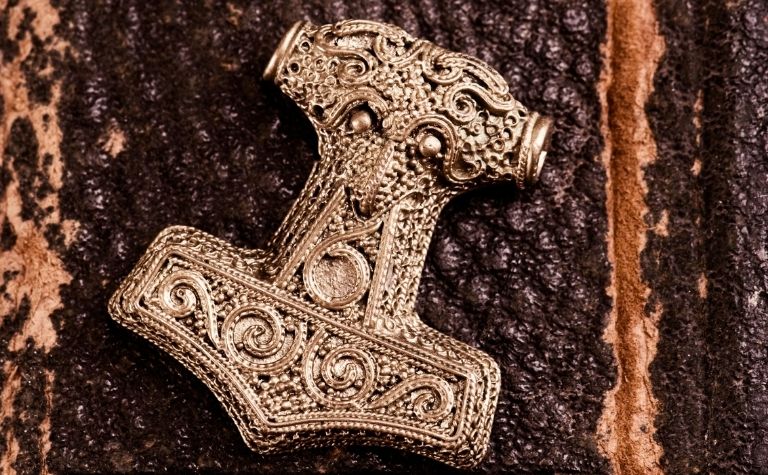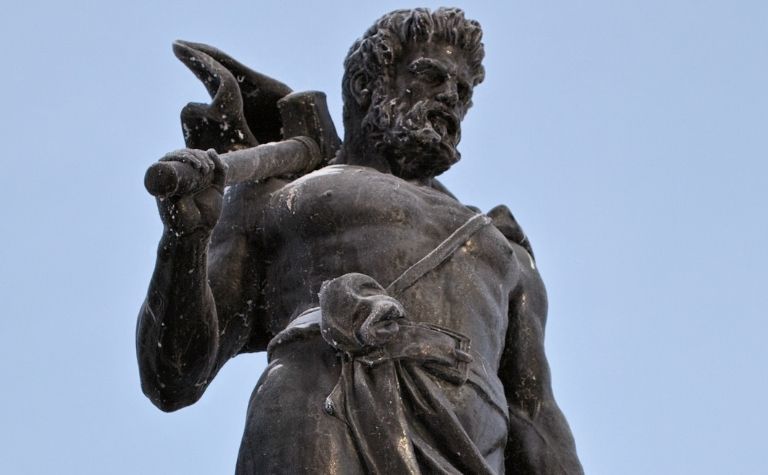In addition to their runic alphabet, the ancient Norse used many symbols to represent social and religiously important items. One of these symbols is that of Thor’s hammer, Mjolnir.
This T-shaped symbol carries with it connotations of protection and blessings.
The Vikings wore Thor’s hammer on amulets, charms, and other pieces of jewelry. Archeologists have discovered many Viking-age necklaces bearing this symbol.
The Vikings believed that Thor’s hammer was useful in battle and had magical properties and the ability to bless or consecrate.
Thor’s hammer conveyed many religious and social meanings. This icon represented blessing, protection, and a belief in traditional Norse paganism, which is why it appears so frequently on Norse artifacts.
Keep reading to learn more.
Also, see Did the Vikings Actual Believe in Thor? to learn more.

What Did the Vikings Believe About Thor?
The Vikings believed Thor was their constant protector who could be counted on to fight on their behalf. Thor blessed their marriages, protected them in battle, and defended their way of life.
Indeed, Thor was a very popular deity among the Vikings. Unlike his father, Odin, Thor was a deity of the common folk, concerned with their everyday lives.
He was a sky god, able to command storms, rain, and sunshine, making Thor very important to farmers.
The Vikings believed that thunder was the sound of Thor’s goat-drawn chariot rolling across the sky or the swinging of his hammer.
Rainfall and good crops were a sign of blessing from Thor.
Thor showed favor to the common people instead of focusing on the nobility, and rarely used deception, relying instead on his strength and willpower.
He was less concerned with magic and knowledge than Odin, making Thor a more practical, relatable god for the ancient Norse.
He was lawful and powerful, trustworthy and ferocious. By wearing the symbol of Mjolnir, the Vikings could honor their favorite god and feel protected from evil.
Also, see Norse Thor vs. Marvel Thor: What’s the Difference? to learn more.

What Is Special About Thor’s Hammer?
Thor’s hammer is special because of its use in battle, its magical properties, and its ability to bless or consecrate. Mjolnir was more than a weapon — it was a holy object.
In myths, Thor used it often when fighting the giants, and it’s also a symbol of chaos and destruction for the ancient Norse.
In one myth, Thor kills and eats goats, then touches Mjolnir to their bones. The next day, the goats are restored to life. His hammer is an instrument of life, not just death.
In another myth, giants steal Mjolnir and use the hammer to bless a marriage ceremony.
Thor dresses as a female giant and pretends to be a bride, and when the giants bring out his hammer to bless the union, Thor takes Mjolnir and kills all the giants at the wedding.
As a symbol, Thor’s hammer meant protection in battle and blessings in birth and marriage.
This symbol carried Thor’s strength and steadfastness, and it reminded the Vikings of their god who fought against the chaotic giants.
Because Mjolnir was Thor’s most famous weapon in myths, it functioned as a symbol of the god himself. Mjolnir’s versatility in mythology as both an instrument of life and death is indicative of Thor’s wide-ranging functions.
He and his hammer were both symbols of war, holiness, safety, and blessings.
The Origins of Thor’s Hammer
According to myths, Thor’s hammer was forged by dwarves. Mjolnir’s creation — and its notably short handle — are actually due to Loki, not Thor.
Loki, a trickster god, looking to cause trouble, cuts off the hair of Sif, Thor’s wife.
Thor is enraged, and Loki promises to make it up to him by convincing the dwarves to make Sif’s new hair out of real gold.
Loki uses his clever wiles to arrange a smithing contest between the dwarves.
A group of dwarves known as the Sons of Ivaldi creates Sif’s golden hair, a boat for Freya, and a spear for Odin.
Loki bets his own head to a pair of brothers, Brokkr and Eitri, that they cannot smith objects as beautiful as the Sons of Ivaldi.
Brokkr and Eitri accept the wager and craft a golden boar for Freya, a ring for Odin, and a hammer for Thor.
But while Brokkr is at work in the forge, a fly — probably a shapeshifting Loki in disguise — bites him.
Brokkr is not bothered at first, and he smiths the boar and rings without trouble.
During the forging of Mjolnir, the fly bites him in the eye. Brokkr stops his smithing to tend to his eye, and as a result, Mjolnir’s handle is too short.
The gods gladly accept their new gifts. Brokkr promises Thor that his new hammer will never fail him in battle and will always return to his hand when thrown.
And even though the hammer’s handle is too short, Brokkr and Eitri win the smithing contest.
But Loki again uses his cleverness, telling the dwarves that he only promised them his head, not his neck.
The dwarves do not behead Loki, but they sew his mouth shut as punishment for his tricks.
Also, see Was Thor a Real Person? to learn more.
What Kind of Jewelry Did the Vikings Have?
For the ancient Norse, jewelry was not just for women. Jewelry was ornamental as well as practical because pins or clasps were used to fasten their clothes.
Pieces of jewelry ranged in size, material, and degree of ornamentation.
The Vikings wore bracelets, armbands, necklaces, brooches, and buckles, but not earrings. Thor’s hammer typically appears on decorative, not practical, pieces of jewelry.
The surviving artifacts that depict Mjolnir are mostly pendants rather than brooches used to fasten clothing.
The symbol for Mjolnir varies from amulet to amulet, but Thor’s hammer is recognizably T-shaped. It looks like an upside-down T, with the wide head of the hammer on the bottom.
Depending on the pendant, the design of Thor’s hammer can be quite complex.
Some Mjolnir symbols include Thor’s face etched into the handle, along with elaborate swirling patterns.
The majority of Norse Mjolnir amulets date back to the same period that Christianity was spreading in Scandinavia.
Some scholars even theorize that the tradition of wearing Thor’s hammer on jewelry was a reaction to the prevalence of Christianity.
Instead of wearing a Christian cross, practicing Norse pagans wore Mjolnir.
Conclusion
The Vikings wore Thor’s hammer to demonstrate their faith and invoked blessing, protection, and favor from their god.
